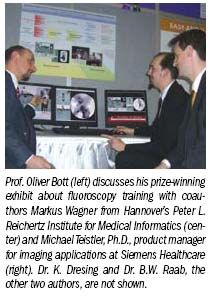- AI
- Molecular Imaging
- CT
- X-Ray
- Ultrasound
- MRI
- Facility Management
- Mammography
Ecstatic informatics group wins high honor for poster
Unbridled joy took hold in the normally subdued poster hall during the RSNA meeting when the first purple summa cum laude rosette given by the panel of judges since 1998 was bestowed upon an elated team of IT specialists.
Unbridled joy took hold in the normally subdued poster hall during the RSNA meeting when the first purple summa cum laude rosette given by the panel of judges since 1998 was bestowed upon an elated team of IT specialists.
“When we saw the award on our exhibit, we just looked at each other and went ‘WOW'! It was so unexpected.” said lead author Oliver Bott, Ph.D., a medical informatics specialist at the University of Applied Sciences and Arts in Hannover, Germany.

The team developed new software for simulation-based C-arm fluoroscopy training to help improve image quality and radiation protection. The tool is of great value to technologists and nurses who perform fluoroscopy during trauma and orthopedic surgeries and who have traditionally undergone their training on actual patients, Bott said. He hopes to make the software available commercially next year, but in the meantime it was due to be used in December at a trauma congress in Davos, Switzerland.
The authors of another 11 exhibits received magna cum laude rosettes, the second category of awards.
Researchers from Massachusetts General Hospital won a prize for their exhibit of common skin findings on breast MRI. They are frequently overlooked clinically and are not well described in the literature, despite their diagnostic importance, according to lead author Sirishma Kalli.
A prize-winning exhibit by Dr. Kamran Shah, a radiologist from the University of Maryland in Baltimore, focused on the complications and postoperative appearance of traumatic facial fractures. Radiologists can provide better information to surgeons if they understand the impact of fractures on facial buttress anatomy and can recognize the common fracture complexes and identify potential complications, Shah said.
Liver Doppler made simple was the theme of the poster by Dr. Dean McNaughton, a radiologist at the University of Iowa. He thinks the understanding of normal liver Doppler waveforms (arteries and veins) requires conceptualization of flow direction and dynamics. There are a limited number of abnormal (pathologic) liver Doppler patterns to remember, and when radiologists have learned these patterns, they can easily reason through the vast majority of pathologic states affecting the liver, he said.
Other magna cum laude winners were Dr. Y. Geffroy from Paris; Dr. R.F. Riascos from Galveston, TX; Dr. W.L. Nowinski from Singapore; Dr. F. Rajouyan from Bethesda, MD; Dr. B.N. Hatton from St. Petersburg, FL; Dr. D. Biyyam from Seattle; and Dr. P.J. Peller from Rochester, MN.
New Literature Review Assesses Merits of Cardiac MRI After Survival of Sudden Cardiac Arrest
April 19th 2024While noting inconsistencies with the diagnostic yield of cardiac MRI in patients who survived sudden cardiac arrest, researchers cited unique advantages in characterizing ischemic cardiomyopathy (ICM) and facilitating alternate diagnoses.
Study of Ofatumumab for Multiple Sclerosis Shows 'Profoundly Suppressed MRI Lesion Activity'
April 17th 2024The use of continuous ofatumumab in patients within three years of a relapsing multiple sclerosis diagnosis led to substantial reductions in associated lesions on brain MRI scans, according to research recently presented at the American Academy of Neurology (AAN) conference.
